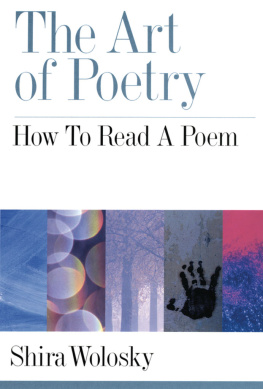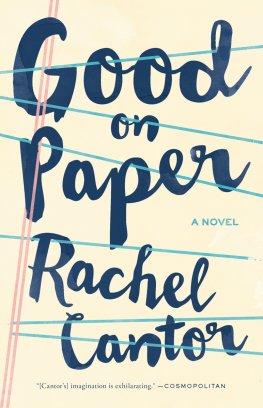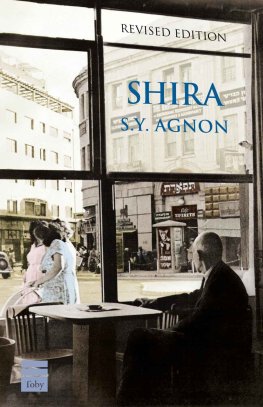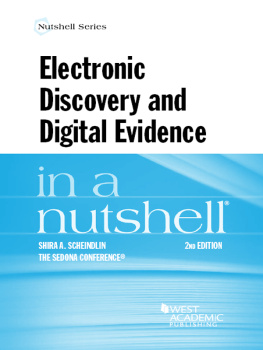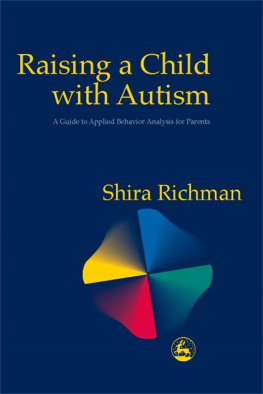Wolosky Shira - The Art of Poetry
Here you can read online Wolosky Shira - The Art of Poetry full text of the book (entire story) in english for free. Download pdf and epub, get meaning, cover and reviews about this ebook. year: 2001, publisher: Oxford University Press USA - OSO, genre: Children. Description of the work, (preface) as well as reviews are available. Best literature library LitArk.com created for fans of good reading and offers a wide selection of genres:
Romance novel
Science fiction
Adventure
Detective
Science
History
Home and family
Prose
Art
Politics
Computer
Non-fiction
Religion
Business
Children
Humor
Choose a favorite category and find really read worthwhile books. Enjoy immersion in the world of imagination, feel the emotions of the characters or learn something new for yourself, make an fascinating discovery.
- Book:The Art of Poetry
- Author:
- Publisher:Oxford University Press USA - OSO
- Genre:
- Year:2001
- Rating:3 / 5
- Favourites:Add to favourites
- Your mark:
- 60
- 1
- 2
- 3
- 4
- 5
The Art of Poetry: summary, description and annotation
We offer to read an annotation, description, summary or preface (depends on what the author of the book "The Art of Poetry" wrote himself). If you haven't found the necessary information about the book — write in the comments, we will try to find it.
The Art of Poetry — read online for free the complete book (whole text) full work
Below is the text of the book, divided by pages. System saving the place of the last page read, allows you to conveniently read the book "The Art of Poetry" online for free, without having to search again every time where you left off. Put a bookmark, and you can go to the page where you finished reading at any time.
Font size:
Interval:
Bookmark:

How to Read a Poem
Shira Wolosky


Oxford University Press, Inc., publishes works that further Oxford Universitys objective of excellence in research, scholarship, and education.
OxfordNew York
AucklandCape TownDar es SalaamHong KongKarachi
Kuala LumpurMadridMelbourneMexico CityNairobi
New DelhiShanghaiTaipeiToronto
With offices in
ArgentinaAustriaBrazilChileCzech RepublicFranceGreece
GuatemalaHungaryItalyJapanPolandPortugalSingapore
South KoreaSwitzerlandThailandTurkeyUkraineVietnam
Copyright 2001 by Oxford University Press, Inc.
Published by Oxford University Press, Inc.
198 Madison Avenue, New York, New York 10016
www.oup.com
First issued as an Oxford University Press paperback, 2008.
Oxford is a registered trademark of Oxford University Press
All rights reserved. No part of this publication may be reproduced, stored in a retrieval system, or transmitted, in any form or by any means, electronic, mechanical, photocopying, recording, or otherwise, without the prior permission of Oxford University Press.
Library of Congress Cataloging-in-Publication Data
Wolosky, Shira, 1954
The art of poetry : how to read a poem / Shira Wolosky.
p.cm.
Includes bibliographical references and index.
ISBN 978-0-19-513870-2; 978-0-19-537118-5 (pbk.)
1. English languageVersification.2. Poetics.3. Poetry.I. Title.
PE1505 .W552001
821.009dc2100-057493
For my children,
Talya,
Elazar,
Tamar,
Nomi
This is a study of poetry in the English tradition, and specifically of poems written in Modern (i.e., post-Medieval) English. In it, I consider great, short lyrics in English from the Renaissance into the twentieth century. The reader will thus be introduced in the course of this book to a core of significant lyric poems that makes up the English tradition. The book, however, is not organized according to chronology. Instead, its structure is topical and cumulative, intending to have the effect of building blocks or progressive overlays. I begin with the smallest integral unit of poetry, the individual word and its selection; then move to the poetic line; then to the fundamental images of simile and metaphor, as these in turn are used as basic structural elements that build larger poetic organizations. The fourth chapter considers the role of metaphor in building the sonnet. The fifth gives a condensed history of the sonnet, showing how verse forms are themselves dynamic historical accumulations as well as flexible, articulate organizations of meanings. I then progressively turn to central elements that organize both small and large units of poetic composition: the figure of personification; questions of poetic voice and of address to an audience; questions of gender. Toward the end, I treat such traditional topics of poetics as meter, sound, and rhyme, followed by a consideration of the role of rhetoric and further tropes in poetic construction, as well as what I call incomplete figures (such as symbols) and the situation of the reader.
Each chapter carries forward, and assumes, the elements of poetry introduced earlier. At times I also glance back at poems discussed in terms of a particular element to add a further layer of interpretation. My method has been to offer readings, in each chapter, of a group of poems, focusing discussion as much as possible through the specific topic, or interest, to which the chapter is devoted. The poems illuminate the topic, and the topic illuminates the poems. I do not offer lists of examples of specific figures or techniques, as is often done in poetry handbooks. Nor do I provide comprehensive lists of kinds of verse, or of technical terms. I have instead approached poetry as a dynamic interaction between numerous formal elements, with the text itself a field of historical reference and change, and addressed to an audience. To do this, I follow the course of a specific elementdiction, or syntax, simile or other rhetorical figures through a single text, to show how it is developed within that text and is vital to its construction. When I return to a poem discussed earlier, I do so from a different angle, in terms of a different element of poetic construction, in order to show how the different features combine and contribute to the effect of the poem as a whole. The result is like the layering of, say, different organ systems in the human body, charting each one but then superimposing one over the other to give an image of the whole. I have reserved for the end the more technical aspects of poetic analysis, such as meter, since I believe these only are meaningful when they are placed within the greater complex of poetic effects, that is, within the full experience of a poem in its many aspects.
Some chapters in this book are concerned mainly with stylistics. Some are more historical; some, more theoretical. This book sets out to re-examine the relationships between these traditional divisions of poetics, often combining them so that each may illuminate the other. It undertakes, first, to historicize formal analysis. Style, format, pattern, convention, and language in poetry are seen as taking shape under conditions of historical change and in the context of widely varying experiences and pressures. Without sacrificing the status of the poem as text and an emphasis on the design of its language, this book treats the poem as a dynamic arena in which elements from outside as well as inside collide and reassemble, in which poets address audiences under particular conditions and in terms of varied cultural interests and understandings. The poetic text emerges as a site of cultural interaction, whose language is open to, and registers, the cultural worlds that situate it and that it in turn interprets and represents. But it is a self-conscious site, a field in which the operations of language become visible. Poetry thus offers a strange and marvelous mirror for seeing how language itself works in shaping our world.
Above all, I have set out to break the closed frame of the poem, to see the poem as an intensive, volatile, transformative site in which many different sorts of language come into a special, self-conscious interaction. In a final section I offer bibliographical backgrounds, to place my own arguments within the context of ongoing poetic discussion.
I would like gratefully to acknowledge Harold Bloom, Geoffrey Hartman, and John Hollander, who developed my sense of poetry as a language of figures; Robert Fagles, Joseph Frank, and Emory Elliott, who gave me a historical sense of literature as dynamic, evolving form; and Sacvan Bercovitch, whose sense of literary and historical interplay has been a deeply felt model and whose encouragement has been a precious support. I wish to thank friends whose discussions have helped shape parts of this book, especially Beverly Haviland, Michael Kramer, Cris Miller, Jeffrey Perl, Gail Berkeley Sherman, and Susanne Wofford. I also want to thank David Kazhdan for his encouragement and comments. I wish to express my deepest personal gratitude to my parents, Blanche and David Wolosky; my sister, Rickey Wolosky Palkovitz; my husband, Ariel Weiss; and my children, Talya, Elazar, Tamar, and Nomi, who have given me a new future and a new past, and for whom this book was in many senses written.
Font size:
Interval:
Bookmark:
Similar books «The Art of Poetry»
Look at similar books to The Art of Poetry. We have selected literature similar in name and meaning in the hope of providing readers with more options to find new, interesting, not yet read works.
Discussion, reviews of the book The Art of Poetry and just readers' own opinions. Leave your comments, write what you think about the work, its meaning or the main characters. Specify what exactly you liked and what you didn't like, and why you think so.

